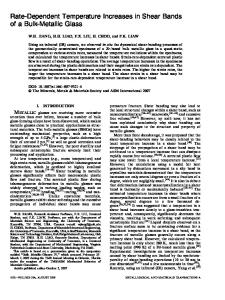Rate dependence of serrated flow in a metallic glass
- PDF / 108,900 Bytes
- 3 Pages / 612 x 792 pts (letter) Page_size
- 103 Downloads / 347 Views
M. Atzmon Department of Nuclear Engineering and Radiological Sciences and Department of Materials Science and Engineering, University of Michigan, Ann Arbor, Michigan 48109 (Received 18 October 2002; accepted 10 January 2003)
Plastic deformation of amorphous Al90Fe5Gd5 was investigated using nanoindentation and atomic force microscopy. While serrated flow was detected only at high loading rates, shear bands were observed for all loading rates, ranging from 1 to 100 nm/s. However, the details of shear-band formation depend on the loading rate.
Plastic deformation of metallic glasses at low temperatures is known to be highly localized to narrow shear bands.1 It is generally believed that shear-band formation is very weakly dependent on the strain rate or temperature.2 However, some reports suggest that the strain rate affects shear-band formation. Mukai et al.3 reported that the density of shear bands in a Pd-based bulk metallic glass increased with strain rate. Schuh et al.4 recently studied the deformation behavior of Pd40Ni40P20 bulk metallic glass by nanoindentation. They observed serrated flow only at strain rates below about 1–10/s. In a Zr-based bulk metallic glass, Wright et al.5 attributed serrated flow behavior to formation of individual shear bands. Consequently, one might conclude that shear bands would form only at low strain rates. However, as Greer et al.6 recently commented, shear-band formation is a high-strain-rate phenomenon. Recently, we also found serrated flow behavior of an Al-based amorphous alloy during nanoindentation at low strain rates. To conclusively determine the formation of shear bands, more direct observations are needed. Here, we present results of nanoindentation and observation of resulting shear bands by atomic force microscopy (AFM). We found shear bands at all strain rates and attribute the observations of Schuh et al. to the instrumental resolution of the nanoindenter. We note that the present discussion is restricted to the low-temperature regime, in which metallic glasses deform inhomogeneously.1 Amorphous Al90Fe5Gd5 ribbon, 22 m thick and 1 mm wide, was obtained by single-wheel melt-spinning in an argon atmosphere using a Cr-coated Cu wheel at a tangential velocity of 40 m/s. Prior to indentation, the ribbon was polished electrolytically using a solution of 25% nitric acid and 75% methanol, at 243 K, and a voltage of 90 V. Indentation experiments were performed using a Nanoinstruments Nanoindenter II (Oak Ridge, J. Mater. Res., Vol. 18, No. 4, Apr 2003
http://journals.cambridge.org
Downloaded: 13 Apr 2015
TN) with a diamond Berkovich indenter. At least ten indents were made on each of the multiple samples. The distance between adjacent indents was 20 m. The loading phase of indentation was carried out under displacement control, and the maximum (elastic plus plastic) indentation depth was 1 m. The thermal drift of the instrument was maintained below 0.2 nm/s. AFM observation on the indents was conducted using a Digital Instruments Nanoscope IIIa (Santa Barbara, CA)
Data Loading...











